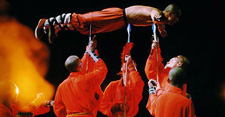SHAOLIN WARRIORS ARTISTS
HISTORY OF SHAOLIN
On a summer day in A.D. 525, a Buddhist monk from India named Bodhi-dharma arrived at the base of Mount Shaoshi in what would later become the Henan province of central China. He took in the scenery, thought or said something to the effect of “This is the place,” and promptly founded the Shaolin monastery — the headquarters of a Buddhist sect that became known across Asia for its disciplined spiritualism and deadly martial-arts prowess. One guesses that Bodhi-dharma had no idea that nearly 1,500 years later, the disciples of Shaolin would still be held in great reverence while demonstrating their remarkable skill and stunning movement to audiences throughout modern-day China and around the world.Recognizing the need to protect themselves in a battle-torn feudal China, the early Shaolin monks embarked on a long process to develop a system of defense by meditating on the attack and defense movements of animals that lived near their monastery. The Shaolin monks called their system of fighting wushu, and after a few centuries of practice, their order was famous far and wide for being a brand of Buddhists that one would be unwise to provoke. However, even with all of their remarkable fighting abilities, the Shaolin monks’ skills are never put to aggressive use. The only exception being of a group of wayward monks who left the monastery around the year A.D. 1620 to form a secret mercenary organization known as White Lotus that specialized in quiet, sure assassinations.
A Note about the Shaolin disciples and Buddhism : It is a commonly held understanding that Buddhism and certainly Buddhist believers espouse a philosophy of non-violence and non-aggression. This philosophy is certainly in accordance with the modern-day practices of the Shaolin disciples and it would be incorrect to associate demonstrations of Shaolin fighting techniques as acts of aggression. One notices that the Shaolin fight mostly in silence, exhibiting what can be described as “stillness in movement,” this “stillness” is a direct result of a serene mind, cultivated through the practice of meditation.
SHAOLIN WARRIORS
Performer Training
The Shaolin performers train in martial arts for several hours every day – perfecting the art of hand-to-hand and weapons combat. Each performer is required to achieve an extraordinarily high level of proficiency in each of the temple’s 18 traditional weapons, and to become a master of one. However, it is the daily practice of seated meditation, which enables the individual performer to sustain a demanding physical regimen. Through a practice known as Ch’an (Chinese for Zen), they calm the body and focus the mind to a single collected point in order to attain a mental state known as Samadhi, or complete mental absorption. It is in this quiet yet highly focused state of mind that they are able to sustain extreme physical discomfort and pain and enable them to undergo the intense daily training required to achieve and maintain the level of adeptness for which they are so highly praised.Shaolin Weapons
There are over 20 weapons used by the Shaolin Kung Fu masters today. They include the common axe, cudgel, spear, halberd, sword and broadsword, 3-section staff, dart, dagger, black tiger hammer, plum blossom broadsword, Bodhidharma staff, tiger hooks and many others. These weapons are equally divided between short and long. Among all these weapons, the cudgel, spear, sword and broadsword, are known together as the four major weapons of Shaolin Kung Fu. Traditionally, Shaolin Kung Fu masters weren’t just commonly armed with the major four. They had many short weapons hidden on the body such as the dart, iron fan and flute, Bhodhidharma staff and many others being solely unique to Shaolin practices. The use of these hidden weapons traditionally gave the Shaolin Kung Fu masters additional power over their enemies. In addition to the employment of these weapons a Shaolin Kung Fu master can utilize virtually any common, everyday object as a weapon.

CONNECT
Artist website










